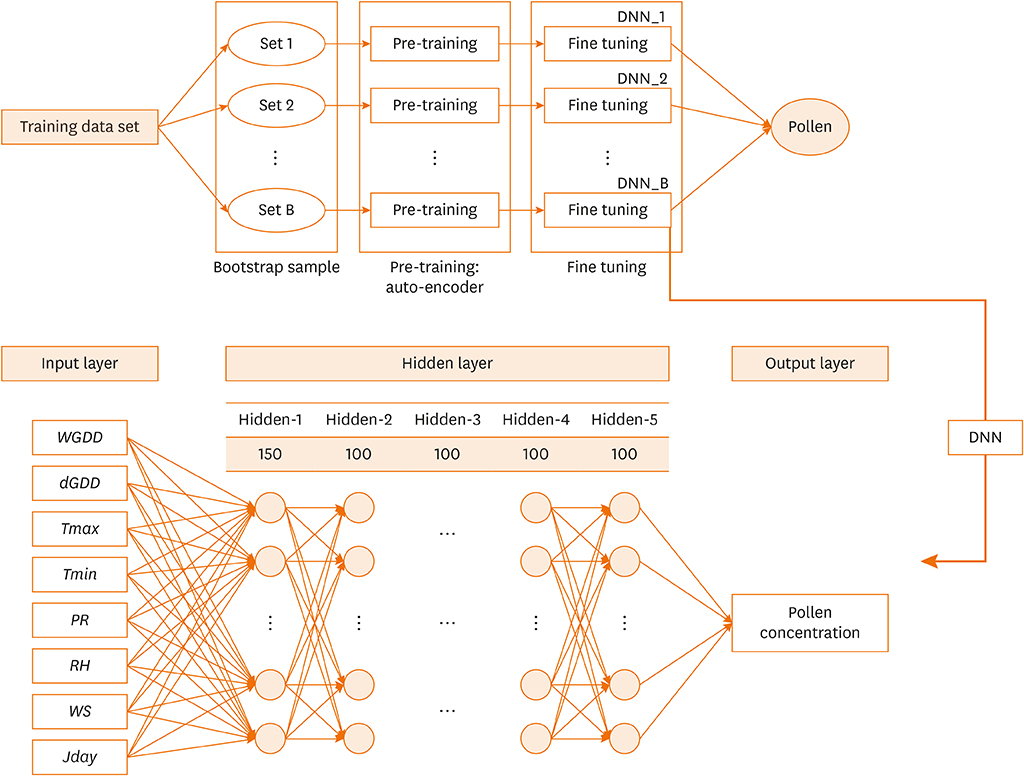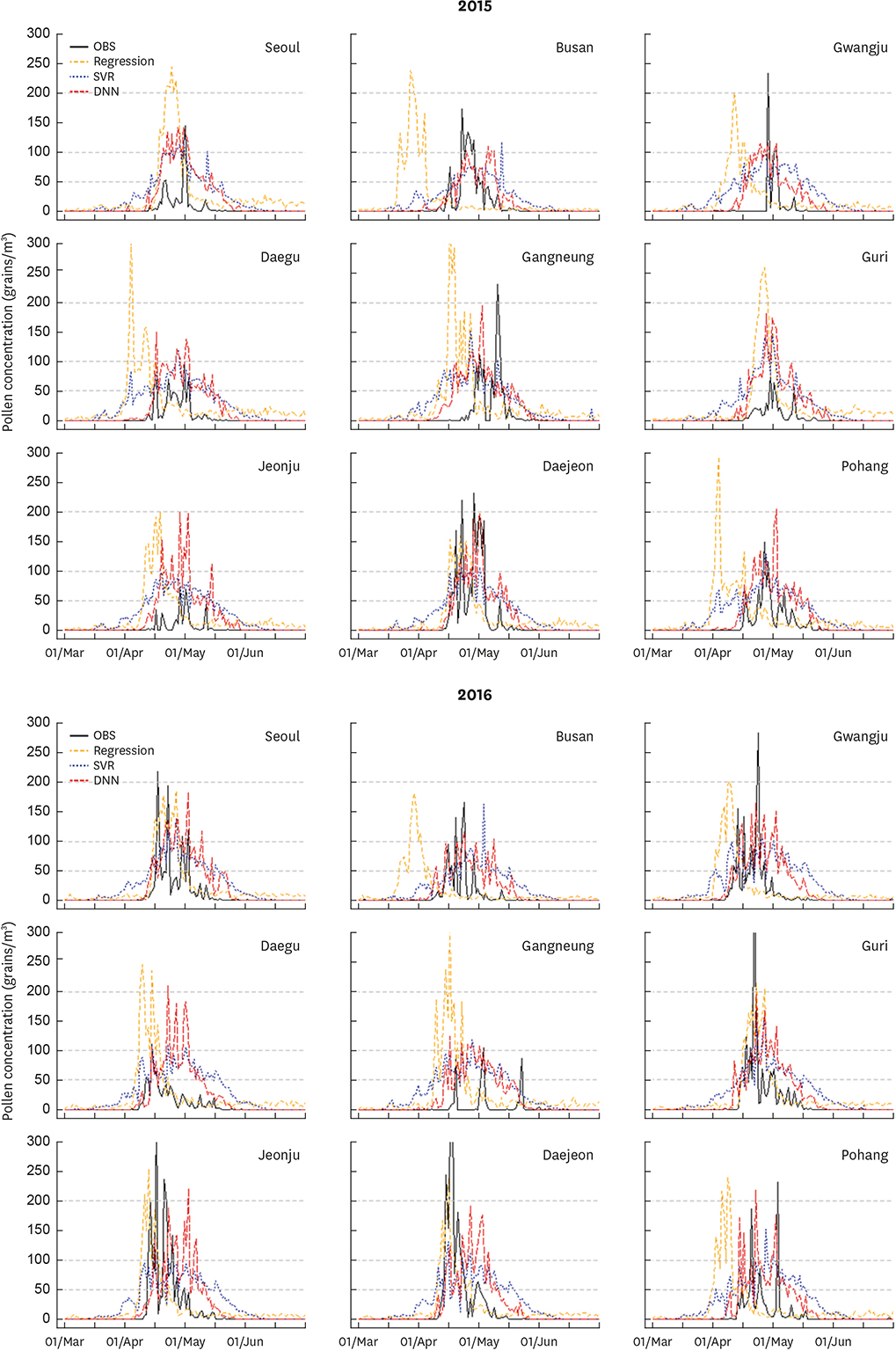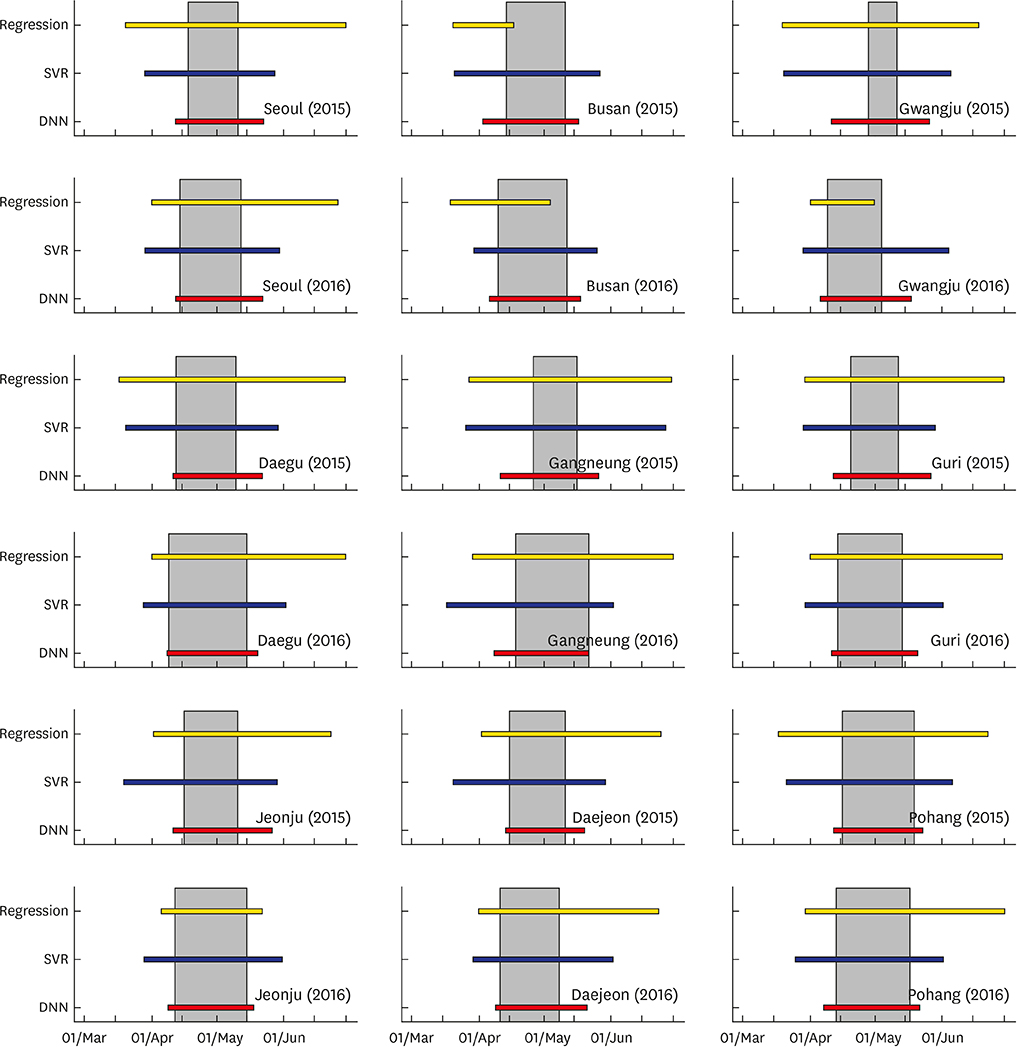Allergy Asthma Immunol Res.
2020 Jan;12(1):149-163. 10.4168/aair.2020.12.1.149.
Deep Neural Network-Based Concentration Model for Oak Pollen Allergy Warning in South Korea
- Affiliations
-
- 1AI Weather Forecast Research Team, National Institute of Meteorological Science, Seogwipo, Korea.
- 2Applied Meteorology Research Division, National Institute of Meteorological Science, Seogwipo, Korea. krk9@kma.go.kr
- 3Department of Pediatrics, Hanyang University College of Medicine, Seoul, Korea.
- 4Urban Forest Research Center, National Institute of Forest Science, Korea Forest Service, Seoul, Korea.
- KMID: 2462579
- DOI: http://doi.org/10.4168/aair.2020.12.1.149
Abstract
- PURPOSE
Oak is the dominant tree species in Korea. Oak pollen has the highest sensitivity rate among all allergenic tree species in Korea. A deep neural network (DNN)-based estimation model was developed to determine the concentration of oak pollen and overcome the shortcomings of conventional regression models.
METHODS
The DNN model proposed in this study utilized weather factors as the input and provided pollen concentrations as the output. Weather and pollen concentration data were used from 2007 to 2016 obtained from the Korea Meteorological Administration pollen observation network. Because it is difficult to prevent over-fitting and underestimation by using a DNN model alone, we developed a bootstrap aggregating-type ensemble model. Each of the 30 ensemble members was trained with random sampling at a fixed rate according to the pollen risk grade. To verify the effectiveness of the proposed model, we compared its performance with those of models of regression and support vector regression (SVR) under the same conditions, with respect to the prediction of pollen concentrations, risk levels, and season length.
RESULTS
The mean absolute percentage error in the estimated pollen concentrations was 11.18%, 10.37%, and 5.04% for the regression, SVR and DNN models, respectively. The start of the pollen season was estimated to be 20, 22, and 6 days earlier than that predicted by the regression, SVR and DNN models, respectively. Similarly, the end of the pollen season was estimated to be 33, 20, and 9 days later that predicted by the regression, SVR and DNN models, respectively.
CONCLUSIONS
Overall, the DNN model performed better than the other models. However, the prediction of peak pollen concentrations needs improvement. Improved observation quality with optimization of the DNN model will resolve this issue.
Keyword
Figure
Reference
-
1. Hong SJ, Ahn KM, Lee SY, Kim KE. The prevalence of asthma and allergic diseases in Korean children. Korean J Pediatr. 2008; 51:343–350.2. Jee HM, Kim KW, Kim CS, Sohn MH, Shin DC, Kim KE. Prevalence of asthma, rhinitis and eczema in Korean children using the International Study of Asthma and Allergies in Childhood (ISAAC) questionnaires. Pediatr Allergy Respir Dis. 2009; 19:165–172.3. Kim HY, Kwon EB, Baek JH, Shin YH, Yum HY, Jee HM, et al. Prevalence and comorbidity of allergic diseases in preschool children. Korean J Pediatr. 2013; 56:338–342.
Article4. Kim KR, Kim M, Choe HS, Han MJ, Lee HR, Oh JW, et al. A biology-driven receptor model for daily pollen allergy risk in Korea based on Weibull probability density function. Int J Biometeorol. 2017; 61:259–272.
Article5. Kim SH, Park HS, Jang JY. Impact of meteorological variation on hospital visits of patients with tree pollen allergy. BMC Public Health. 2011; 11:890.
Article6. Hong CS. Pollen allergy plants in Korea. Allergy Asthma Respir Dis. 2015; 3:239–254.
Article7. Beggs PJ. Impacts of climate change on aeroallergens: past and future. Clin Exp Allergy. 2004; 34:1507–1513.
Article8. D'Amato G, Holgate ST, Pawankar R, Ledford DK, Cecchi L, Al-Ahmad M, et al. Meteorological conditions, climate change, new emerging factors, and asthma and related allergic disorders. A statement of the World Allergy Organization. World Allergy Organ J. 2015; 8:25.9. Kim KR, Park H, Lee H, Kim MJ, Choi Y, Oh J. Development and evaluation of the forecast models for daily pollen allergy. Korean J Agric For Meteorol. 2012; 14:265–268.
Article10. Grinn-Gofroń A, Strzelczak A. Artificial neural network models of relationships between Alternaria spores and meteorological factors in Szczecin (Poland). Int J Biometeorol. 2008; 52:859–868.
Article11. Puc M. Artificial neural network model of the relationship between Betula pollen and meteorological factors in Szczecin (Poland). Int J Biometeorol. 2012; 56:395–401.
Article12. Iglesias-Otero MA, Fernández-González M, Rodríguez-Caride D, Astray G, Mejuto JC, Rodríquez-Rajo FJ. A model to forecast the risk periods of Plantago pollen allergy by using the ANN methodology. Aerobiologia (Bologna). 2015; 31:201–211.
Article13. Astray G, Fernández-González M, Rodríguez-Rajo FJ, López D, Mejuto JC. Airborne castanea pollen forecasting model for ecological and allergological implementation. Sci Total Environ. 2016; 548-549:110–121.
Article14. NIMS. Current status of pollen observational network in Korea and application of the data. Technical note series NIMS-TN-2015-011. Seogwipo: NIMS;2015.15. Breiman L. Bagging predictors. Mach Learn. 1996; 24:123–140.
Article16. Efron B. Bootstrap methods: another look at the jackknife. Ann Stat. 1979; 7:1–26.
Article17. Efron B, Tibshirani RJ. An introduction to the bootstrap. Boca Raton (FL): Chapman and Hall/CRC;1994.18. Hinton GE, Osindero S, Teh YW. A fast learning algorithm for deep belief nets. Neural Comput. 2006; 18:1527–1554.
Article19. Rumelhart DE, Hinton GE, Williams RJ. Learning representations by back-propagating errors. Nature. 1986; 323:533–536.
Article20. Bourlard H, Kamp Y. Auto-association by multilayer perceptrons and singular value decomposition. Biol Cybern. 1988; 59:291–294.
Article21. Hinton GE, Zemel RS. Autoencoders, minimum description length, and Helmholtz free energy. Adv Neural Inf Process Syst. 1994; 6:3–10.22. Bengio Y, Lamblin P, Popovici D, Larochelle H. Greedy layer-wise training of deep networks. In : Schölkopf B, Platt J, Hoffman T, editors. Advances in neural information processing systems, vol. 19. Cambridge (MA): MIT Press;2007. p. 153–160.23. Crouzy B, Stella M, Konzelmann T, Calpini B, Clot B. All-optical automatic pollen identification: towards an operational system. Atmos Environ. 2016; 140:202–212.
Article24. Oteros J, Pusch G, Weichenmeier I, Heimann U, Möller R, Röseler S, et al. Automatic and online pollen monitoring. Int Arch Allergy Immunol. 2015; 167:158–166.
Article25. Kawashima S, Thibaudon M, Matsuda S, Fujita T, Lemonis N, Clot B, et al. Automated pollen monitoring system using laser optics for observing seasonal changes in the concentration of total airborne pollen. Aerobiologia (Bologna). 2017; 33:351–362.
Article26. O'Connor DJ, Healy DA, Hellebust S, Buters JT, Sodeau JR. Using the WIBS-4 (Waveband Integrated Bioaerosol Sensor) technique for the on-line detection of pollen grains. Aerosol Sci Technol. 2014; 48:341–349.27. Wagner J, Macher J. Automated spore measurements using microscopy, image analysis, and peak recognition of near-monodisperse aerosols. Aerosol Sci Technol. 2012; 46:862–873.
Article28. Zhang J. Developing robust non-linear models through bootstrap aggregated neural networks. Neurocomputing. 1999; 25:93–113.
Article29. Franke J, Neumann MH. Bootstrapping neural networks. Neural Comput. 2000; 12:1929–1949.
Article30. Ha K, Cho S, MacLachlan D. Response models based on bagging neural networks. J Interact Market. 2005; 19:17–30.
Article31. Granitto PM, Verdes PF, Ceccatto HA. Neural network ensembles: evaluation of aggregation algorithms. Artif Intell. 2005; 163:139–162.
Article32. Tiwari MK, Chatterjee C. Uncertainty assessment and ensemble flood forecasting using bootstrap based artificial neural networks (BANNs). J Hydrol (Amst). 2010; 382:20–33.
Article33. Wen G, Hou Z, Li H, Li D, Jiang L, Xun E. Ensemble of deep neural networks with probability-based fusion for facial expression recognition. Cognit Comput. 2017; 9:597–610.
Article34. Geem ZW, Kim JH, Loganathan GV. A new heuristic optimization algorithm: harmony search. Simulation. 2001; 76:60–68.
Article35. Kulluk S, Ozbakir L, Baykasoglu A. Self-adaptive global best harmony search algorithm for training neural networks. Procedia Comput Sci. 2011; 3:282–286.
Article36. In : Rosa GH, Papa JP, Marana AN, Scheirer WJ, Cox DD, editors. Fine-tuning convolutional neural networks using harmony search. 20th Iberoamerican Congress; 2015 Nov 9–12; Montevideo, Uruguay. Geneva: Springer;2015. 10. p. 683.37. Papa JP, Scheirer W, Cox DD. Fine-tuning deep belief networks using harmony search. Appl Soft Comput. 2016; 46:875–885.
Article
- Full Text Links
- Actions
-
Cited
- CITED
-
- Close
- Share
- Similar articles
-
- The impact of climate change on pollen allergy in Korea
- Cross - reactivity between pollens in patients sensitlzed to multiple pollens
- Revision of threshold levels for evoking pollinosis to oak, pine, Japanese hop, and ragweed in the metropolitan area Seoul, Korea
- Pollen allergy plants in Korea
- Development of Pollen Concentration Prediction Models




